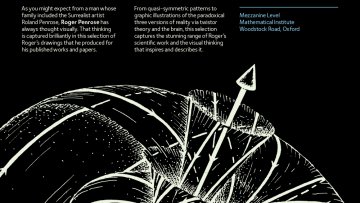As you might expect from a man whose family included the Surrealist artist Roland Penrose, Roger Penrose has always thought visually. That thinking is captured brilliantly in this selection of Roger’s drawings that he produced for his published works and papers.
From quasi-symmetric patterns to graphic illustrations of the paradoxical three versions of reality via twistor theory and the brain, this selection captures the stunning range of Roger’s scientific work and the visual thinking that inspires and describes it.
Mezzanine Level
Mathematical Institute
Oxford
10 December 2019- 31 March 2020
[[{"fid":"56998","view_mode":"media_397x223","fields":{"format":"media_397x223","field_file_image_alt_text[und][0][value]":false,"field_file_image_title_text[und][0][value]":false},"type":"media","field_deltas":{"1":{"format":"media_397x223","field_file_image_alt_text[und][0][value]":false,"field_file_image_title_text[und][0][value]":false}},"attributes":{"class":"media-element file-media-397x223","data-delta":"1"}}]]


